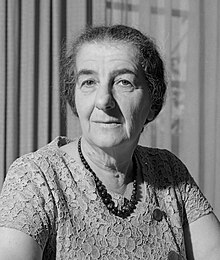Golda Meir | |
|---|---|
גולדה מאיר | |
 Meir in 1964 | |
| 4th Prime Minister of Israel | |
| In office 17 March 1969 – 3 June 1974 | |
| President | Zalman Shazar Ephraim Katzir |
| Preceded by | Yigal Allon (interim) |
| Succeeded by | Yitzhak Rabin |
| Leader of Labor Party | |
| In office 17 March 1969 – 3 June 1974 | |
| Preceded by | Levi Eshkol |
| Succeeded by | Yitzhak Rabin |
| Minister of Interior | |
| In office 16 July 1970 – 1 September 1970 | |
| Prime Minister | Herself |
| Preceded by | Haim-Moshe Shapira |
| Succeeded by | Yosef Burg |
| Minister of Foreign Affairs | |
| In office 19 June 1956 – 12 January 1966 | |
| Prime Minister | David Ben-Gurion Levi Eshkol |
| Preceded by | Moshe Sharett |
| Succeeded by | Abba Eban |
| Minister of Labor | |
| In office 10 March 1949 – 19 June 1956 | |
| Prime Minister | David Ben-Gurion Moshe Sharett |
| Preceded by | Mordechai Bentov |
| Succeeded by | Mordechai Namir |
| Member of the Knesset | |
| In office 12 February 1949 – 3 June 1974 | |
| Minister Plenipotentiary to the Soviet Union | |
| In office 10 September 1948 – 25 January 1949 | |
| Preceded by | Office established |
| Succeeded by | Mordechai Namir |
| Personal details | |
| Born | Golda Mabovitch 3 May 1898 Kyiv, Russian Empire |
| Died | 8 December 1978 (aged 80) West Jerusalem |
| Political party | Poale Zion (1915–1919) Ahdut HaAvoda (1919–1930) Mapai (1930–1968) Labor Party (1968–1978) |
| Other political affiliations | Alignment (1969–1978) |
| Spouse |
Morris Meyerson
(m. 1917; died 1951) |
| Children | 2 |
| Alma mater | Milwaukee State Normal School |
| Signature |  |
Golda Meir[nb 1] (née Mabovitch; 3 May 1898 – 8 December 1978) was an Israeli politician who served as the fourth prime minister of Israel from 1969 to 1974. She was Israel's first and only female head of government and the first in the Middle East.[5]
Born into a Ukrainian-Jewish family in Kyiv in what was then the Russian Empire, Meir immigrated with her family to the United States in 1906. She graduated from the Milwaukee State Normal School and found work as a teacher. While in Milwaukee, she embraced the Labor Zionist movement. In 1921, Meir and her husband immigrated to Mandatory Palestine, settling in Merhavia, later becoming the kibbutz's representative to the Histadrut. In 1934, she was elevated to the executive committee of the trade union. Meir held several key roles in the Jewish Agency during and after World War II. She was a signatory of the Israeli Declaration of Independence in 1948. Meir was elected to the Knesset in 1949 and served as Labor Minister until 1956, when she was appointed Foreign Minister by Prime Minister David Ben-Gurion. She retired from the ministry in 1966 due to ill health.
In 1969, Meir assumed the role of prime minister following the death of Levi Eshkol. Early in her tenure, she made multiple diplomatic visits to western leaders to promote her vision of peace in the region. The outbreak of the Yom Kippur War in 1973 caught Israel off guard and inflicted severe early losses on the army. The resulting public anger damaged Meir's reputation and led to an inquiry into the failings. Her Alignment coalition was denied a majority in the subsequent legislative election; she resigned the following year and was succeeded as prime minister by Yitzhak Rabin. Meir died in 1978 of lymphoma and was buried on Mount Herzl.
A controversial figure in Israel, Meir has been lionized as a founder of the state and described as the "Iron Lady" of Israeli politics, but also widely blamed for the country being caught by surprise during the war of 1973. In addition, her dismissive statements towards the Palestinians were widely scorned.[6] Most historians believe Meir was more successful as Minister of Labour and Housing than as Premier.[7]
- ^ "Meir". Collins English Dictionary. HarperCollins. Archived from the original on June 26, 2019. Retrieved June 26, 2019.
- ^ "Meir, Golda". Lexico UK English Dictionary. Oxford University Press. Archived from the original on February 25, 2021.
- ^ "Meir". Merriam-Webster.com Dictionary. Merriam-Webster. Retrieved June 26, 2019.
- ^ "Golda Meir: An Outline of a Unique Life: A Chronological Survey of Gola Meir's Life and Legacy". The Golda Meir Center for Political Leadership (Metropolitan State University of Denver). Archived from the original on October 18, 2012. Retrieved February 20, 2014. Reference on name pronunciation (see "1956").
- ^ Kort, Michael (2002). The Handbook of the Middle East. Lerner Publishing Group. p. 76. ISBN 9781315170688. Archived from the original on April 20, 2023. Retrieved February 21, 2023.
- ^ Cite error: The named reference
TOIGMwas invoked but never defined (see the help page). - ^ Cite error: The named reference
Meron Medziniwas invoked but never defined (see the help page).
Cite error: There are <ref group=nb> tags on this page, but the references will not show without a {{reflist|group=nb}} template (see the help page).